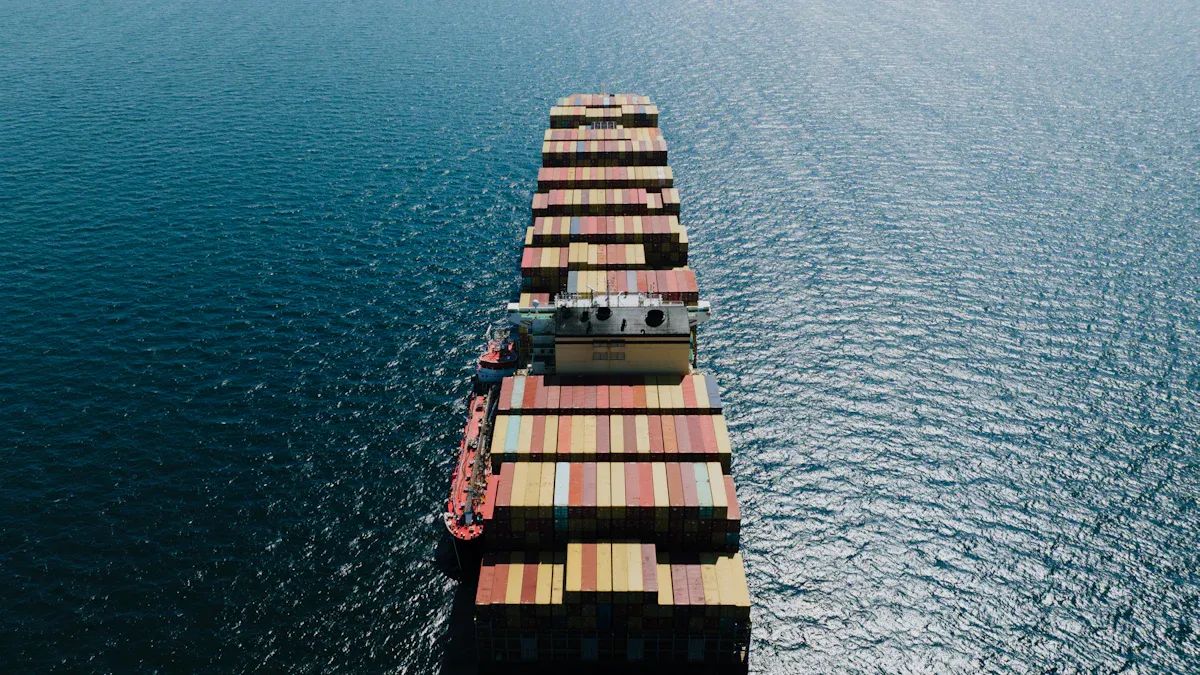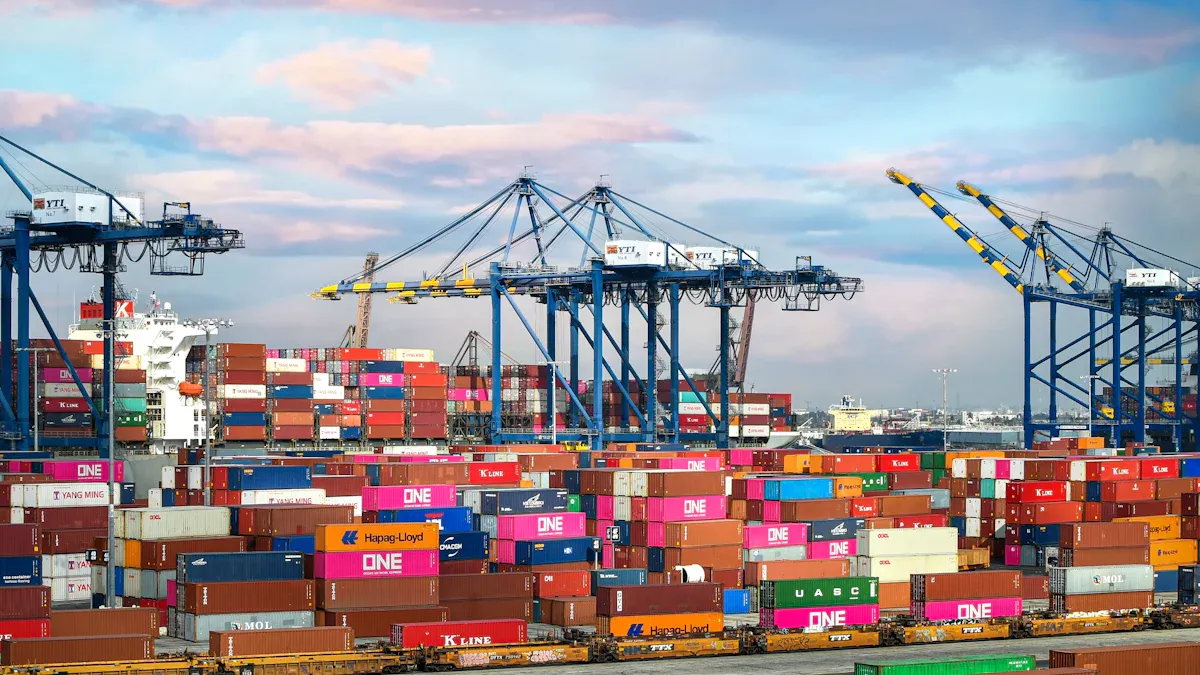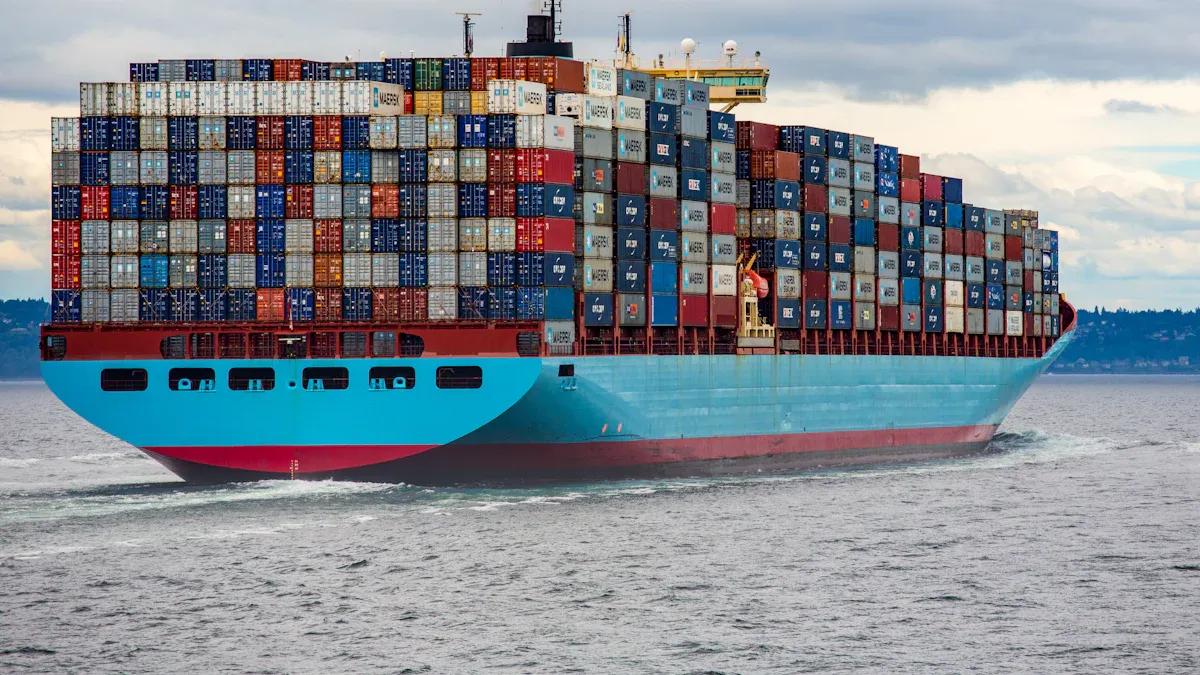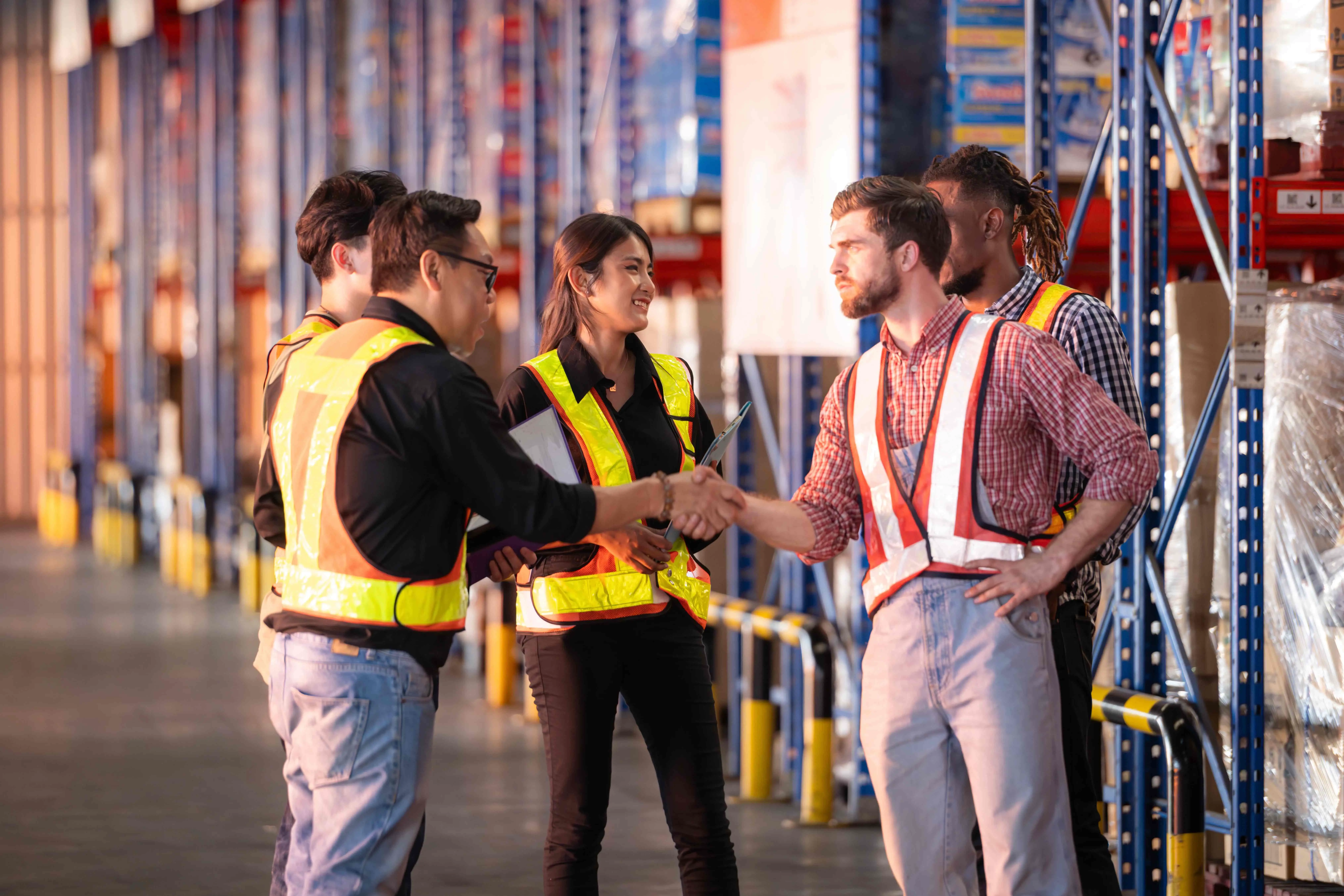How to Navigate Ocean Freight Shipping in 2025

Ocean shipping plays a crucial role in facilitating the movement of goods between countries with ease. Understanding this process is essential for maintaining a strong business. Effective planning allows you to adapt to new changes seamlessly. By planning ahead, you can keep costs steady and minimize risks. Advanced tools like AI can predict prices, while real-time tracking provides live updates on shipments.
Key Takeaways
Plan early to handle changes in ocean freight shipping. This keeps costs low and reduces risks.
Pick the best shipping option for your needs. Use Full Container Load (FCL) for big shipments. Use Less than Container Load (LCL) for smaller ones to save money.
Use tools like GPS tracking and AI to manage shipments. These tools give live updates and help make better choices.
Understanding Ocean Freight Shipping in 2025
What is ocean freight shipping?
Ocean freight shipping means moving goods across the sea in containers. It is a key part of global trade, handling about 90% of goods worldwide. This method costs less than air freight, so many businesses prefer it. For instance, a furniture company shipping many couches would use Full Container Load (FCL). A small business might choose Less than Container Load (LCL) to share space with others. Special services like Roll-On/Roll-Off (Ro-Ro) are great for vehicles. Break bulk shipping is used for big items like heavy machines.
Why ocean freight remains vital for global trade in 2025
Ocean freight is still important because it moves large amounts of goods easily. After the pandemic, more people want products, so shipping is needed. Online shopping has also increased demand for flexible options like LCL. Changes in manufacturing, like nearshoring, have shifted shipping routes but kept ocean freight essential. Even with challenges like higher fuel costs and stricter emission rules, ocean shipping is still key for connecting the world.
Key trends shaping ocean freight shipping today
Several trends are changing ocean freight shipping in 2025:
Fluctuating Costs: Fuel prices and new rules are raising shipping rates.
Geopolitical Factors: Trade rules and sanctions affect routes and costs.
Technological Advancements: Automated ports and digital tools make shipping faster.
Sustainability Initiatives: New emission rules push for greener shipping methods.
Evolving Trade Routes: Nearshoring changes where goods are shipped.
For example, shipping costs on big routes like Asia-Europe and Transpacific have gone up by 11% and 18%. These changes show why businesses must adjust their shipping plans to stay ahead.
Types of Ocean Freight Shipping Services
Full Container Load (FCL)
Full Container Load (FCL) is used when your goods fill a container. You get the whole container, which keeps your items safer. This service reduces handling, lowering the chance of damage. For example, a furniture company shipping many couches would use FCL. It also uses space well, making it cheaper for big shipments.
Type of Service | Description | Benefits |
|---|---|---|
Full Container Load (FCL) | One shipper uses the entire container. | Saves space, less handling, better control over goods. |
Less than Container Load (LCL)
Less than Container Load (LCL) works for smaller shipments that don’t need a full container. You share space with others, which lowers costs. For example, a small business shipping crafts can save money with LCL. The Asia-Pacific LCL market is growing fast and may reach USD 13.29 billion by 2030. This shows more people want affordable and flexible shipping options.
Tip: Choose LCL to save money and ship smaller loads efficiently.
Roll-on/Roll-off (Ro-Ro)
Roll-on/Roll-off (Ro-Ro) is great for cars and heavy equipment. You can drive them onto the ship without taking them apart. This method avoids damage and speeds up loading. In 2023, global car shipping grew by 17%, showing Ro-Ro is popular for vehicles. If you work in the car industry, this service delivers items safely and quickly.
Specialized Cargo Services
Specialized cargo services handle unique goods like cold, large, or dangerous items. Reefer containers keep food or medicine fresh with controlled temperatures. Hazardous goods are shipped in special containers that follow safety rules. These services are perfect for industries needing extra care, like medical or heavy equipment sectors.
Note: Reefer containers use advanced systems to monitor temperature and humidity, keeping items in top condition.
Step-by-Step Guide to the Ocean Freight Shipping Process

Step 1: Know what you need to ship
Figure out what you are shipping and its destination. Think about the size, weight, and type of goods. Fragile items need special care, while big items need custom containers. Keeping accurate records is very important. It helps avoid mistakes like delays or lost cargo. Set clear rules for managing this data to save time and avoid errors.
Tip: Combine small shipments into one big load to save money.
Step 2: Pick the best ocean freight service
Choose a service that fits your shipment. Use Full Container Load (FCL) for large goods and Less than Container Load (LCL) for smaller ones. Ro-Ro is great for cars, and special services handle items like cold or dangerous goods. Check things like cost, quality, and tracking tools. For example, GPS tracking helps you see where your shipment is at all times.
Factor | What it Means |
|---|---|
Service Quality | Reliable delivery prevents problems. |
Cost Considerations | Check prices and extra fees to control costs. |
Technology and Tracking | Tools like GPS help track shipments and improve logistics. |
Step 3: Get your shipment ready (packaging, labels, documents)
Good preparation keeps your shipment safe. Use strong, waterproof packaging to protect items. Add labels like "Fragile" or "Handle with Care." Prepare key documents like the bill of lading and packing list. These papers are needed for customs and shipping.
Note: Follow ISPM-15 rules for wood packaging to avoid fines.
Step 4: Book your shipment with freight forwarders or carriers
Freight forwarders make booking easier. Ask for a quote, confirm details, and prepare documents. They help with rules and find good prices. Building trust with carriers can also get you better deals.
Get a quote and book space on a ship.
Share shipment details and check documents.
Approve and send documents to the right people.
Step 5: Clear customs and follow rules
Customs can be tricky. Make sure all papers, like customs forms, are correct. Wrong details can cause delays or fines. Learn about trade rules and taxes to avoid problems.
Tip: Let a freight forwarder handle customs to save time.
Step 6: Track your shipment and finish delivery
Use tools like GPS and RFID to track your shipment live. Geo-fencing alerts you if something goes off course. These tools give quick updates so you can fix problems fast. When the shipment arrives, complete delivery papers to finish the process.
Technology | What It Does | Benefits |
|---|---|---|
GPS Tracking | Tracks location in real time | Helps manage shipments better |
RFID Technology | Scans items quickly | Speeds up work in warehouses |
Choosing the Right Ocean Freight Forwarders and Partners
Key qualities to look for in a freight forwarder
Picking the right freight forwarder makes shipping easier. Find one that fits your business needs. Good service is very important. A dependable forwarder delivers on time and communicates well. Costs are also important. Check shipping rates and hidden fees to stay on budget. Technology is another key point. Tools like GPS tracking and EDI give live updates and improve clarity.
Criteria | Description |
|---|---|
Reliable delivery avoids delays and keeps schedules on track. Clear communication is also important. | |
Cost Considerations | Look at shipping rates and extra fees to plan your budget. |
Technology and Tracking | Use tools like GPS and EDI for better shipment tracking. |
Role of Freight Forwarders | They handle logistics, paperwork, and rules to make shipping easier. |
Questions to ask potential ocean freight forwarders
Asking smart questions helps you pick the best partner. Start by asking about their experience with global shipping. Check if they have a strong network for your routes. Ask how fast they solve problems and how accurate their paperwork is. These show how reliable they are. Also, check if they use modern tools. A forwarder with good tech can improve your shipping process.
Tip: Ask for reviews or ratings to see how good their service is.
Evaluating reliability, cost, and customer service
Reliability, cost, and service are key when choosing a forwarder. Check how well they work with carriers and manage inventory. A forwarder with fewer claims and good capacity ensures smooth shipping. Customer service is also important. It builds trust and helps you succeed in global trade.
Metric | Description |
|---|---|
Carrier Performance | Ensures safe and on-time delivery, keeping customers happy. |
Shows how often mistakes happen; fewer claims mean better service. | |
Customer Satisfaction Score | Measures how happy customers are and helps improve services. |
Using smart systems can cut costs and make shipping faster. Pick a forwarder who is great at these things.
Modern Technologies and Trends in Ocean Freight Shipping

Digital freight platforms and automation
Digital freight tools are changing how shipments are managed. These tools make tasks like booking and pricing faster. Automation helps avoid mistakes and saves time. For example, using big data improves planning and keeps things running smoothly. These platforms also give live updates and clear pricing, making customers happier.
Benefit | Description |
|---|---|
Better customer experience | Tools improve pricing and keep clients satisfied. |
Smooth operations | Automation cuts errors and boosts efficiency. |
Shared information | Platforms link transport modes, saving time and money. |
Blockchain for transparency and security
Blockchain makes shipping safer and more open. It turns paperwork into digital files, speeding up processes. Sharing data across the supply chain builds trust between partners. Blockchain also tracks every step to stop fraud. This technology ensures honesty and accountability.
Sharing data builds trust and clarity.
Accurate info helps partners work better together.
Fraud is reduced with secure tracking systems.
Sustainability initiatives and green shipping practices
Shipping is going greener with new energy sources like wind and solar. Zero-emission ships and eco-friendly materials lower pollution. These changes help companies meet global goals and look better to customers. Tracking carbon emissions shows a company’s commitment to the environment.
New energy systems power ships with less pollution.
Zero-emission ships aim to cut carbon output.
Eco-friendly materials reduce harm to nature.
AI and predictive analytics for better decision-making
AI and smart tools are improving ocean shipping. They fix data problems and give real-time updates. For example, AI reduces tracking mistakes, which happen often with old methods. Predictive tools help businesses make better choices, saving time and keeping customers happy.
AI improves routes and safety.
Smart tools help make better decisions.
Real-time updates boost efficiency.
How JUSDA leverages technology for efficient ocean shipping
JUSDA uses smart tools to make shipping easier. Live tracking shows where shipments are and helps solve problems fast. AI tools speed up customs checks and reduce mistakes. Route planning tools cut travel time and costs. JUSDA also combines shipments to save space and money.
Technology Used | Benefit |
|---|---|
Route Planning | Cuts travel time and shipping costs. |
Live Tracking | Helps manage problems quickly. |
Customs Tools | Speeds up checks and avoids delays. |
AI Systems | Reduces errors and improves processes. |
Managing Costs and Understanding Ocean Freight Rates
Factors influencing ocean freight rates in 2025
Many things affect ocean freight rates in 2025. Longer routes cost more because of distance. Busy ports can add extra fees, from $150 to $500 per container. Fuel prices also have a big impact. For example, in 2022, higher oil prices caused fuel fees to rise by 20–30%. New rules for cutting carbon emissions also raise costs as carriers switch to greener methods.
Scenario | Description |
|---|---|
Moderate Increase | Oil prices stay steady, causing a 5–10% rise in costs. |
Significant Rate Fluctuations | Political issues lead to sudden jumps in shipping charges. |
Declining Freight Rates | Less demand during economic slowdowns lowers shipping prices. |
Note: Slow steaming saves fuel but makes shipping take longer.
Tips for reducing shipping costs
You can save money on shipping by using smart methods:
Pick the right service, like FCL for big loads or LCL for small ones.
Combine small shipments to fill containers fully.
Check invoices carefully to avoid surprise fees.
Work closely with carriers to get better deals.
Plan routes wisely to find cheaper options.
Tip: Pack items well to save space and prevent damage, which lowers costs.
The role of fuel surcharges and other fees
Fuel surcharges are a big part of shipping costs. Carriers change these fees based on fuel prices. When fuel costs go up, shipping gets pricier, but lower fuel prices don’t always mean cheaper rates. Other fees, like seasonal demand charges, also affect costs. For instance, during busy times, prices rise because space is limited.
Cost-saving solutions offered by JUSDA
JUSDA offers smart ways to cut shipping costs. Their tools plan better routes, saving time and money. Real-time data helps manage costs more accurately. They also combine small shipments to use container space better, lowering expenses. These solutions make JUSDA a trusted partner for affordable ocean shipping.
Common Problems in Ocean Freight Shipping and Ways to Solve Them
Shipping Delays and Supply Chain Problems
Shipping delays can mess up supply chains. Bad weather, political issues, or worker strikes often cause these problems. For example, the Red Sea Crisis made ships take longer routes, doubling costs by late 2024. Busy seasons also crowd ports, making wait times longer.
Planning ahead can help avoid these issues. Tools for tracking shipments and planning routes reduce delays. Delivering goods on time lowers storage costs and keeps customers happy. Advanced tracking systems also fix mistakes, like tracking the wrong ship, which happens to 17% of logistics companies.
Dealing with Complicated Customs Rules
Customs rules are different in every country, making them hard to follow. Missing or wrong paperwork can lead to fines and delays. Keeping records and checking them often helps avoid these problems. Digital tools make it easier by giving live updates and fixing errors in documents.
Companies like Avon make customs easier by staying updated on rules and sharing changes with clients. These steps reduce paperwork and make customs clearance faster.
Handling Risks Like Damaged or Lost Cargo
Cargo damage or loss is a big worry in ocean shipping. Bad weather, theft, or political problems are common risks. Storage issues also cause losses, especially during natural disasters. For example, the Beirut port explosion in 2020 caused $2 billion in insured losses.
To reduce these risks, use cargo insurance to protect goods. Faster shipping services can also avoid delays. Planning routes and tracking shipments in real time help prevent problems.
How JUSDA Solves Shipping Problems
JUSDA uses smart tools to fix shipping problems. Their live tracking systems improve visibility and reduce mistakes. AI tools make customs checks faster and more accurate. JUSDA plans better routes to avoid delays and cut costs. They also combine shipments to save space and money. These solutions make JUSDA a trusted partner for solving ocean freight challenges.

JUSDA Solutions
To provide you with professional solutions and quotations.
To handle ocean shipping in 2025, plan carefully and stay informed. Learn about new trends and rules to prevent problems. Use smart tools to track shipments and control costs. Work with trusted companies like JUSDA for smooth shipping. These actions improve your process and keep you ahead in business.
